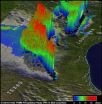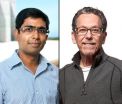(Press-News.org) April 5, 2012 - Old houses and vacant lots may not look like much to the naked eye, but to some, the site is better than gold. Excavations over the years can create a challenge to study what's left behind and often appears as if dirt and debris ended up mixed in a blender then pressed by a giant trash compactor.
However, in Detroit, one scientist and geologist is finding some of the city's abandoned lots provide a surprising "natural laboratory" for studying certain processes involved in soil formation; particularly the weathering of rocky and mineral objects within the soil layers. Jeffrey Howard's analyzed soil in the heart of the Motor City since he first dug an experimental pit on the site of a demolished building a few blocks away from his office at Wayne State University. And Howard says what he's been finding ever since, continues to amaze him, leading to his newest research.
"With an urban soil, we know what 'time zero' is," says Howard. "We don't know that as well in nature." If he's working on a vacant lot where the building was demolished in 1969, for example, "that's when the soil started to form." Howard's learned he can further date the processes in his "natural laboratory" by digging at sites where a dated cornerstone or other historical record tells him exactly how long the processes have been taking place. He's also finding Detroit the perfect starting place, where urban soil is slowly revealing the city's story as a world leader from the Industrial Revolution through World War II, to the now dramatic contraction of surplus houses, abandoned factories and crumbling landmarks.
The results map the passage of time, showing some of the old underground debris may be having a beneficial effect in certain polluted soils. And he's finding a mix of manipulated conditions. Howard says,"They didn't know that's what they were doing then, but scientifically, now we're able to see something that we otherwise wouldn't have seen. And that's huge."
###
See the complete results from this study in the just released, online only publication, Soil Horizons, at: https://www.soils.org/publications/sh/articles/53/2/6
This featured article of SH is available for free access at https://www.soils.org/publications/sh until the next quarterly issue.
Soil Horizons https://www.soils.org/publications/sh aim is to share the importance of soil science with a larger audience. It features stories celebrating the diversity and critical impact of soil scientists and their work. Soil Horizons also serves as an outlet for the publication of peer-reviewed papers on global issues and solutions in the study of soils, along with emerging challenges, ideas, unique field experiences, and findings. But these papers may break from the traditional to explore everything from case studies as examples of a larger issue, to experiential papers with implications for further study or changes in practice. Soil Horizons is published by the Soil Science Society of America.
The Soil Science Society of America (SSSA) is a progressive, international scientific society that fosters the transfer of knowledge and practices to sustain global soils. Based in Madison, WI, SSSA is the professional home for 6,000+ members dedicated to advancing the field of soil science. It provides information about soils in relation to crop production, environmental quality, ecosystem sustainability, bioremediation, waste management, recycling, and wise land use.
SSSA supports its members by providing quality research-based publications, educational programs, certifications, and science policy initiatives via a Washington, DC, office. Founded in 1936, SSSA celebrates its 75th Anniversary this year (2011). For more information, visit www.soils.org or follow @SSSA_soils on Twitter.
History of abandoned urban sites found stored in soil
Process of urban soil being studied, Detroit offers natural laboratory setting
2012-04-10
ELSE PRESS RELEASES FROM THIS DATE:
New research reveals food ingredients most prone to fraudulent economically motivated adulteration
2012-04-10
Rockville, Md., April 5, 2012 — In new research published in the April Journal of Food Science, analyses of the first known public database compiling reports on food fraud and economically motivated adulteration in food highlight the most fraud-prone ingredients in the food supply; analytical detection methods; and the type of fraud reported. Based on a review of records from scholarly journals, the top seven adulterated ingredients in the database are olive oil, milk, honey, saffron, orange juice, coffee, and apple juice.
The database was created by the U.S. Pharmacopeial ...
Copper chains: Study reveals Earth's deep-seated hold on copper
2012-04-10
Earth is clingy when it comes to copper. A new Rice University study this week in the journal Science finds that nature conspires at scales both large and small -- from the realms of tectonic plates down to molecular bonds -- to keep most of Earth's copper buried dozens of miles below ground.
"Everything throughout history shows us that Earth does not want to give up its copper to the continental crust," said Rice geochemist Cin-Ty Lee, the lead author of the study. "Both the building blocks for continents and the continental crust itself, dating back as much as 3 billion ...
Big advance against cystic fibrosis
2012-04-10
Harvard stem cell researchers at Massachusetts General Hospital (MGH) have taken a critical step in making possible the discovery in the relatively near future of a drug to control cystic fibrosis (CF), a fatal lung disease that claims about 500 lives each year, with 1,000 new cases diagnosed annually.
Beginning with the skin cells of patients with CF, Jayaraj Rajagopal, MD, and colleagues first created induced pluripotent stem (iPS) cells, and then used those cells to create human disease-specific functioning lung epithelium, the tissue that lines the airways and is ...
Scientists discover new threat to birds posed by invasive pythons
2012-04-10
Smithsonian scientists and their colleagues have uncovered a new threat posed by invasive Burmese pythons in Florida and the Everglades: The snakes are not only eating the area's birds, but also the birds' eggs straight from the nest. The results of this research add a new challenge to the area's already heavily taxed native wildlife. The team's findings are published in the online journal Reptiles & Amphibians: Conservation and Natural History.
Burmese pythons, native to southern Asia, have taken up a comfortable residence in the state of Florida, especially in the Everglades. ...
Study reveals impact of socioeconomic factors on the racial gap in life expectancy
2012-04-10
Differences in factors such as income, education and marital status could contribute overwhelmingly to the gap in life expectancy between blacks and whites in the United States, according to one of the first studies to put a number on how much of the divide can be attributed to disparities in socioeconomic characteristics.
A Princeton University study recently published in the journal Demography reveals that socioeconomic differences can account for 80 percent of the life-expectancy divide between black and white men, and for 70 percent of the imbalance between black ...
Researchers discover unique suspension technique for large-scale stem cell production
2012-04-10
Post-doctoral researcher David Fluri and Professor Peter Zandstra at the University of Toronto's Institute of Biomaterials and Biomedical Engineering (IBBME) have developed a unique new technique for growing stem cells that may make possible cost-effective, large-scale stem cell manufacturing and research.
Although stem cells are widely used for the testing of new drugs, researchers have always faced difficulties manufacturing enough viable cells from a culture. Typically, stem cells are grown on surfaces that must be scraped, and which must then be differentiated from ...
NASA's TRMM Satellite sees tornadic Texas storms in 3-D
2012-04-10
NASA's Tropical Rainfall Measuring Mission (TRMM) satellite provides a look at thunderstorms in three dimensions and shows scientists the heights of the thunderclouds and the rainfall rates coming from them, both of which indicate severity.
Powerful thunderstorms that created severe weather were more than 8 miles high.
NOAA's National Weather Service Storm Prediction Center received 18 reports of tornadoes occurring on April 3 over northeastern Texas. Some of these very destructive storms dropped softball sized hail as they passed to the south of the Dallas/Fort ...
Women cannot rewind the 'biological clock'
2012-04-10
Many women do not fully appreciate the consequences of delaying motherhood, and expect that assisted reproductive technologies can reverse their aged ovarian function, Yale researchers reported in a study published in a recent issue of Fertility and Sterility.
"There is an alarming misconception about fertility among women," said Pasquale Patrizio, M.D., professor in the Department of Obstetrics & Gynecology at Yale School of Medicine and director of the Yale Fertility Center. "We also found a lack of knowledge about steps women can take early in their reproductive ...
Salk scientists redraw the blueprint of the body's biological clock
2012-04-10
La Jolla, CA----The discovery of a major gear in the biological clock that tells the body when to sleep and metabolize food may lead to new drugs to treat sleep problems and metabolic disorders, including diabetes.
Scientists at the Salk Institute for Biological Studies, led by Ronald M. Evans, a professor in Salk's Gene Expression Laboratory, showed that two cellular switches found on the nucleus of mouse cells, known as REV-ERBα and REV-ERBβ, are essential for maintaining normal sleeping and eating cycles and for metabolism of nutrients from food.
The findings, ...
Which plants will survive droughts, climate change?
2012-04-10
New research by UCLA life scientists could lead to predictions of which plant species will escape extinction from climate change.
Droughts are worsening around the world, posing a great challenge to plants in all ecosystems, said Lawren Sack, a UCLA professor of ecology and evolutionary biology and senior author of the research. Scientists have debated for more than a century how to predict which species are most vulnerable.
Sack and two members of his laboratory have made a fundamental discovery that resolves this debate and allows for the prediction of how diverse ...
LAST 30 PRESS RELEASES:
Air pollution exposure and birth weight
Obstructive sleep apnea risk and mental health conditions among older adults
How talking slows eye movements behind the wheel
The Ceramic Society of Japan’s Oxoate Ceramics Research Association launches new international book project
Heart-brain connection: international study reveals the role of the vagus nerve in keeping the heart young
Researchers identify Rb1 as a predictive biomarker for a new therapeutic strategy in some breast cancers
Survey reveals ethical gaps slowing AI adoption in pediatric surgery
Stimulant ADHD medications work differently than thought
AI overestimates how smart people are, according to HSE economists
HSE researchers create genome-wide map of quadruplexes
Scientists boost cell "powerhouses" to burn more calories
Automatic label checking: The missing step in making reliable medical AI
Low daily alcohol intake linked to 50% heightened mouth cancer risk in India
American Meteorological Society announces Rick Spinrad as 2026 President-Elect
Biomass-based carbon capture spotlighted in newly released global climate webinar recording
Illuminating invisible nano pollutants: advanced bioimaging tracks the full journey of emerging nanoscale contaminants in living systems
How does age affect recovery from spinal cord injury?
Novel AI tool offers prognosis for patients with head and neck cancer
Fathers’ microplastic exposure tied to their children’s metabolic problems
Research validates laboratory model for studying high-grade serous ovarian cancer
SIR 2026 delivers transformative breakthroughs in minimally invasive medicine to improve patient care
Stem Cell Reports most downloaded papers of 2025 highlight the breadth and impact of stem cell research
Oxford-led study estimates NHS spends around 3% of its primary and secondary care budget on the health impacts of heat and cold in England
A researcher’s long quest leads to a smart composite breakthrough
Urban wild bees act as “microbial sensors” of city health.
New study finds where you live affects recovery after a hip fracture
Forecasting the impact of fully automated vehicle adoption on US road traffic injuries
Alcohol-related hospitalizations from 2016 to 2022
Semaglutide and hospitalizations in patients with obesity and established cardiovascular disease
Researchers ‘listen in’ to embryo-mother interactions during implantation using a culture system replicating the womb lining
[Press-News.org] History of abandoned urban sites found stored in soilProcess of urban soil being studied, Detroit offers natural laboratory setting



